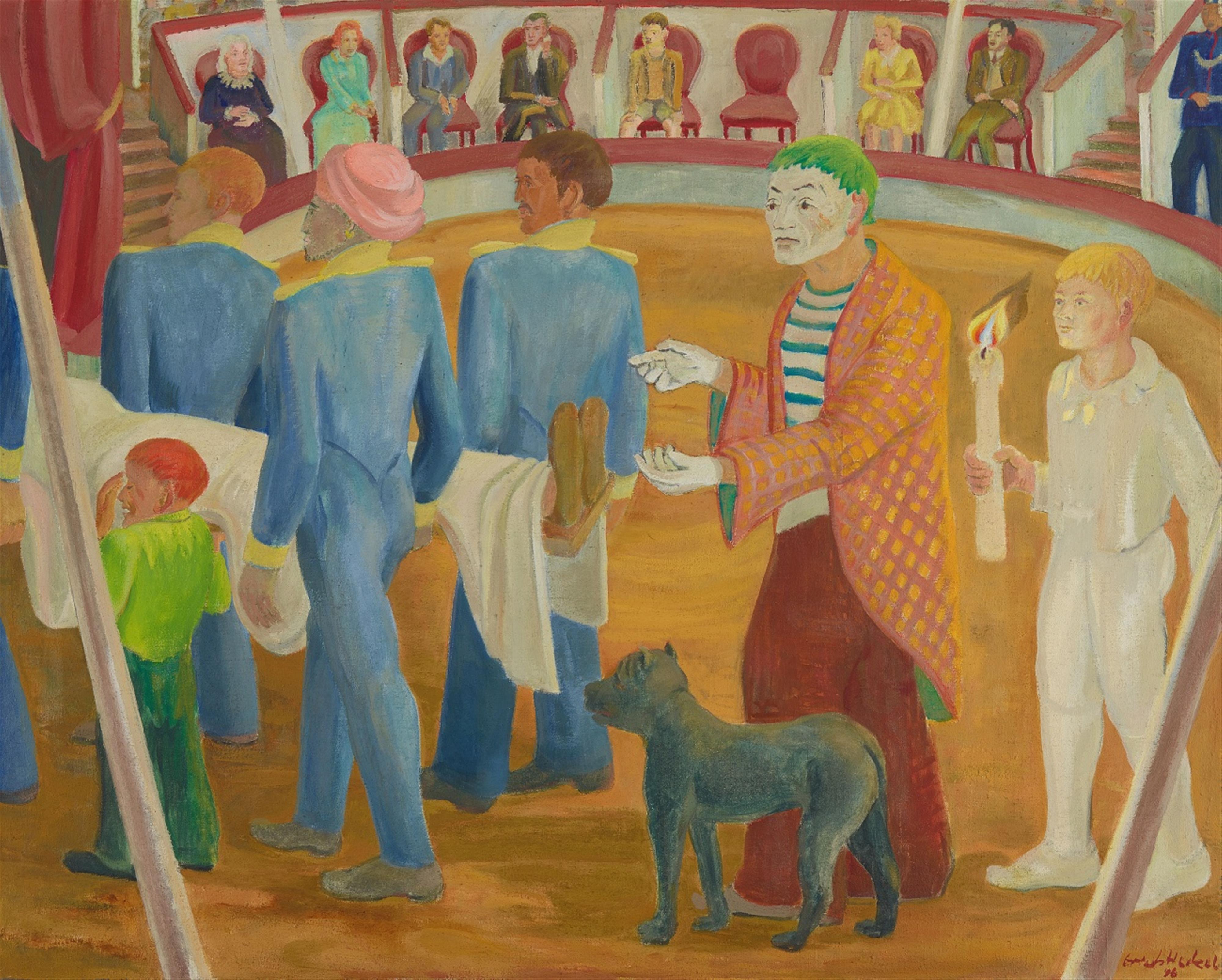Erich Heckel
Zirkusszene
1946
Tempera on canvas 96,8 x 120 cm Framed (original framing). Signed and dated 'Erich Heckel 46' in reddish brown lower right as well as additionally signed and dated 'Erich Heckel 46' in black verso upper right on the whitewashed canvas and signed, dated and titled 'Erich Heckel: "Zirkus-Scene." 1946' on the stretcher bar upper left. Inscribed 'Erich Heckel. Hemmenhofen' in brush on the upper bar of the original frame to the left. - In fine condition.
Artists, actors and circus artistes often appear to be kindred spirits; they pursue a career and follow their intuition, they achieve wonderful feats, appear to be proud and unbound by the laws of nature and are nonetheless endangered. Their art, their skills that appear so playful are a balancing act over an abyss. Circus artistes have always exerted a huge fascination on their audience, because they are associated with metaphysics and tragedy and their striving can in many regards be seen as a transparent parable of the conditio humana. Not only colours, atmosphere, the acrobatics and the grotesque facets of variety theater and the circus provided artistic subjects, thematically, the performance of the artistes and the clown represented reciprocal dualities. As an Expressionist Heckel was intrigued by these subtle phenomena.
In this respect Erich Heckel's "Zirkusszene" dating from 1946 is also a mysterious, almost surreal event. He toys with various aspects in terms of meaning and pictorial program in this "finale" that makes you wish a fanfare would end everything, everything would turn out fine as if this had just been a somewhat macabre intermezzo. Indeed, the artist is not very explicit, not everything is visible... but things are serious. Who is the person lying there on the stretcher? What does this solemn mortal “departure” mean - we are familiar with the rituals -, here leaving the arena and in costume? Even the animal is suffering and mourns the death of the juggler, or was it a jester? Someone has been hit. The old, deeply moved clown seems to be an alter ego of the artist, a “wise man” and the comforting eternal light follows in the guise of a young, white Pierrot holding a burning candle. A central ringside seat is left vacant. Is it all theater? The spectators of the “Zirkusszene”, a betrayed “act”, have quietly remained in their seats.
Erich Heckel was the member of the Brücke artists considered to be a sensitive and melancholy observer. It is easy to forget the importance he assigned to artistes, clowns and the circus in his work as many of his paintings exploring these topics no longer exist today, were burned or lost. From 1909/1912 the theme runs like a red thread through all the decades of his active life as an artist and appears in all the techniques he used, was more frequent in the 1920s and early 1930s, in 1940 and finally in the years after the catastrophe of World War II. Parallel to this in the early 1910s it is already noticeable how often he addressed the topic of death in combination with the figure of Pierrot and the clown. Heckel was inspired by Dostojewsky and as late as 1917 by Jean Paul and he found scenic aspects of expression in silent films resp. movies that resounded with him. After the destruction of his major painting "Lon Chaney” from 1930 in World War II Heckel reproduced it from memory 1946 under the title “Clown vor dem Spiegel" (today in the Folkwang Museum, Essen), in the very same year of “Zirkusszene”. Heckel was a sensitive portraitist, his works featuring similar scenes, particularly the self-portraits, reflect artistically a quest of human identity.
Catalogue Raisonné
Hüneke 1946-5; Vogt 1946/4
Provenance
Erich Heckel, Hemmenhofen; acquired from the artist, formerly Franz Elles, Cologne (1965), estate
Literature
W. Kern, Erich Heckel, in: Internationale Bodenseezeitschrift 2, 1952, p. 40-44, in particular p. 43; Katharina Henkel, Dialog der Medien - Motive in Aquarell und Öl bei Heckel, Zirkuswelt, in: Magdalena M. Moeller (ed.), Erich Heckel. Der Stille Expressionist. Aquarelle als Vorstudien zu Gemälden, exhib. cat. (i.a.) Brücke-Museum Berlin, Munich 2009, p.30, cf. cat. nos. 97, 98, each with colour illus. of the painting; Andreas Hüneke, Erich Heckel, Werkverzeichnis der Gemälde, Wandbilder und Skulpturen, vol. II., Hemmenhofen 2017, p. 291 with colour illus. (mentioning 7 watercolours as preliminary studies, some donated by Siddi Heckel to the Brücke-Museum)
Exhibitions
Darmstadt 1948 (Mathildenhöhe), Secession Darmstadt, cat. no. 76; Freiburg im Breisgau/Mannheim 1950 (Kunstverein/Kunsthalle Mannheim), Erich Heckel, cat. no. 38; Münster 1953 (Westfälisches Landesmuseum), Erich Heckel, Zur Vollendung des siebenten Lebensjahrzehntes, cat. no. 87; Konstanz 1961 (Kunstverein), Erich Heckel, cat. no. 20; Nuremberg/Pforzheim 1964 (Fränkische Galerie/ Kunst- und Kunstgewerbeverein), Erich Heckel, cat. no. 28

